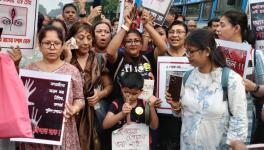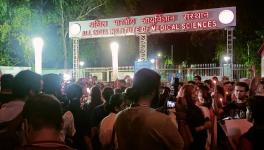TMC’s Sweep in Kolkata Troubling, but Signals Political Realignment

Kolkata Municipal Corporation Borough Office No. II
The Kolkata Municipal Corporation elections resulted in a stunning sweep for the Trinamool Congress (TMC). The results, declared on 21 December, recorded what was practically the complete elimination of an Opposition.
For the record, TMC won 134 of the 144 wards on offer; the Bharatiya Janata Party (BJP) won three wards; the Left Front won two; the Congress won two; and Independents won three wards. West Bengal Chief Minister and TMC boss Mamata Banerjee is slated to meet the newly elected councillors on 23 December to sort out who gets what post in the new dispensation. It is most likely that the three Independents will join the ruling party on the sidelines of the meeting, boosting the TMC’s numbers to 137-95% of the House.
This electoral outcome is deeply troubling: any house with practically no Opposition must necessarily be an emasculated one. There are questions about how this came about. Selective rigging is the allegation that all opposition parties have levelled, but there are other factors. The immediate and more urgent issue raised by the numbers thrown up concerns the shape of things to come for Bengal politics. The TMC won a gargantuan and scarcely believable percentage of the votes—72%. Trailing in second place was the Left Front with 11.89%. They were followed by the BJP, with 9.21%, and the Congress with 4.12%.
The comparable figures for the 2015 KMC elections in the same order were 50.84, 24.50, 15.42 and 6.62 per cent. But this comparison is largely academic. The more important comparison is with the figures thrown up by the disaggregated figures of the Assembly elections held earlier this year, the results of which were declared on 2 May. By this metric, the TMC’s vote share went up by 11%; the BJP’s share went down by 20%; the Left Front’s rose by 7%; and the Congress was more or less static.
The comparison with the 2019 Lok Sabha election reinforces the main point. The disaggregated figures are hard to get, but in the three constituencies that are wholly or partly in the KMC jurisdiction, the vote shares were as follows: in Kolkata Dakshin, the TMC got 47.5%, the BJP 34.6% and the Left Front 11.6%; in Kolkata Uttar the numbers in sequence were, 50, 36.6 and 7.5 per cent; and in Jadavpur (only partially in the KMC area), the numbers were 47.9, 27.4 and 21 per cent.
From these figures one thing is obvious that the BJP has been going downhill in Kolkata from its 2019 peak, the Left Front has improved its position, pulling itself up by the bootstraps, and the ruling party has cemented its domination spectacularly. Other figures support this trend. Contesting 128 wards, the Left Front finished second in 65, while the BJP contesting 142 wards finished second in 42. The BJP had leads in 51 wards in 2019, 12 earlier this year and ended up winning only three, with 116 candidates managing to lose their deposits—that works out to a shade over 80%. Left Front candidates lost their deposits in 97 wards, which works out to 75%.
Let us take our leave of the dismal field of statistics at this point to make the obvious point: a realignment of political forces seems to be in the works, with the Left Front reclaiming its position as the main player in the opposition space, pushing the BJP down the pecking order. Two points need to be made in this connection, however. First, we shall have to wait for another couple of months when phased elections will be held for the 110 other urban local bodies in Bengal to see whether this trend holds up.
Second, and perhaps more important, it is obvious that the votes that had travelled to the BJP from the Left Front and which the Hindutva peddlers have haemorrhaged have not all travelled back to the Left. Instead, a large part has gone to the TMC, though some of it has been retrieved by the Left. Nevertheless, to borrow from the lexicon of economists, the Left Front has good reason to see some green shoots. But it has to water these now. Part of the reason for the Left’s recovery has been the sterling work it has done during the various calamities that have befallen the people: the Covid-19 outbreak, supercyclone Amphan and cyclone Yaas. The problem, however, seems to be that its powers of mobilisation have waned. This is the area which it has to concentrate on. In doing this, it has to take both the TMC and the BJP head on, aiming to marginalise the BJP. Contrary to perception, it’s possible.
The related question, of course, is whatever happened to the BJP? The spectacular decline it has suffered mirrors its spectacular ascent in 2019. There seems to be a mix of factors. The state unit of the party has always been a bit of joke—lacking organisational muscle and riven by factionalism. In the aftermath of the humbling in Kolkata, the camp followers of MP Dilip Ghosh, former state president of the party, are reported to have complained that he and his associates were kept out of the process of election management. The state unit was rejigged on 22 December, the changes were largely cosmetic, but also indicated the state unit’s disarray.
Thus, the BJP in Bengal is forever looking to Delhi to make it tick. For the KMC elections, the national leadership remained disengaged, perhaps busy with the prospects of looming contests in the heartland. Nevertheless, it must be said that a strategy premised on Delhi leading the charge will not work in Bengal, as the Assembly elections conclusively showed. Absent unrealistic disbursements from its admittedly swollen war chest, it will decline further, giving the Left the space to reinvent itself.
Which brings us to the issue of rigging. There is little doubt that there were irregularities. Huge margins, resembling those found in Assembly elections, and the large percentage of votes won in some wards by TMC candidates—seven got more than 90% of the vote—attest to this. But the scale of the win should remind us that there can be no doubt that the TMC’s popularity has increased dramatically.
The KMC results also focus attention on the TMC’s recent attempts to enlarge its footprints – in the Northeast generally and in Goa, the latter being a distinctly quixotic venture. A regional party can, of course, have larger ambitions, but these must follow a political logic. The TMC’s foray into Goa and its destructive comments about the United Progressive Alliance and the Congress suggest political sabotage.
Some believe, not entirely irrationally, that the TMC has struck a deal with the BJP, which will involve the latter keeping its snout out of Bengal, while the latter helps it by sabotaging Opposition unity. This suspicion could be uncharitable though given the emergence of reports that the TMC and the Congress have established ‘back-channel’ communications.
It is to be hoped that Banerjee’s aggression is some kind of grandstanding and that sooner rather than later she will realize the importance of Opposition unity and be a reliable and responsible team player. Given her mercurial temperament and keeping in mind the obscurity of her political calculations, however, one need not hold one’s breath.
The author is an independent journalist and researcher. The views are personal
Get the latest reports & analysis with people's perspective on Protests, movements & deep analytical videos, discussions of the current affairs in your Telegram app. Subscribe to NewsClick's Telegram channel & get Real-Time updates on stories, as they get published on our website.
























